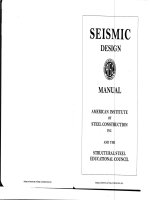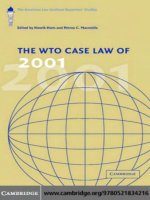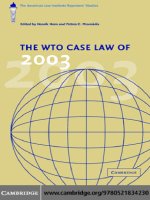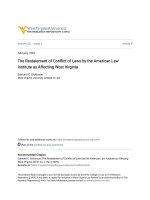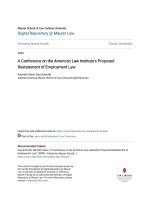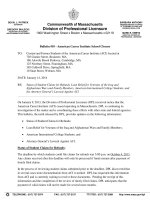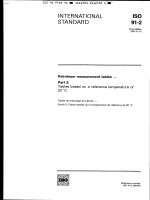Api publ 305 1991 scan (american petroleum institute)
Bạn đang xem bản rút gọn của tài liệu. Xem và tải ngay bản đầy đủ của tài liệu tại đây (4.5 MB, 156 trang )
PROTECTING AGRIGULTURAL CROPS
FROM OZONE EXPOSURES
KEY ISSUES AND FUTURE RESEARCH
DIRECTIONS
--`,,-`-`,,`,,`,`,,`---
HEALTH AND ENVIRONMENTAL AFFAIRS
API PUBLICATION NUMBER 305
AUGUST 1991
Ame rican Pet roieum Institute
1220 L Street, Northwest
Washington, D.C. 20005
11’
Copyright American Petroleum Institute
Provided by IHS under license with API
No reproduction or networking permitted without license from IHS
Not for Resale
A P I PUBL*305
93
0732290 0554354 885
--`,,-`-`,,`,,`,`,,`---
PROTECTING AGRICULTURAL CROPS FROM
OZONE EXPOSURES
KEYISSESANDFUTURERESEARCH
DIRECTIONS
Health and Environmental Affairs Department
API PUBLICATION NUMBER 305
AUGUST 1991
PREPARED UNDER CONTRACT BY:
ALLEN S. LEFOHN, PH.D. AND JANELL K. FOLEY
A.S.L. & ASSOCIATES
HELENA, MT
American
Petroleum
Institute
Copyright American Petroleum Institute
Provided by IHS under license with API
No reproduction or networking permitted without license from IHS
Not for Resale
~~
~
A P I PUBL+305 91
= 0732290 0554355 711
FOREWORD
API PUBLICATIONS NECESSARILY ADDRESS PROBLEMS OF A
GENERAL NATURE. WITH RESPECT TO PARTICULAR
CIRCUMSTANCES, LOCAL, STATE AND FEDERAL LAWS AND
REGULATIONS SHOULD BE REVIEWED.
API IS NOT UNDERTAKING TO MEET THE DUTIES OF EMPLOYERS,
MANUFACTURERS, OR SUPPLIERS TO WARN AND PROPERLY TRAIN
AND EQUIP THEIR EMPLOYEES, AND OTHERS EXPOSED,
CONCERNING HEALTH AND SAFETY RISKS AND PRECAUTIONS, NOR
UNDERTAKING THEIR OBLIGATIONS UNDER LOCAL, STATE, OR
FEDERAL,LAWS.
NOTHING CONTAINED IN ANY AF'I PUBLICATION IS TO BE
CONSTRUED AS GRANTING ANY RIGHT, BY IMPLICATION OR
OTHERWISE, FOR THE MANUFACTURE, SALE, OR USE OF ANY
METHOD, APPARATüS, OR PRODUCT COVERED BY LEïTERS PATENT.
NEITHER SHOULD ANYTHING CONTAINED IN THE PUBLICATION BE
CONSTRUED AS INSURING ANYONE AGAINST LIABILITY FOR
INFRINGEMENT OF LEïïT3S PATENT.
Copyright 8 1991 Amencan Petrdeaun institute
--`,,-`-`,,`,,`,`,,`---
Copyright American Petroleum Institute
Provided by IHS under license with API
No reproduction or networking permitted without license from IHS
Not for Resale
= 0732290 0554356
~~
APT PUBL*305
9%
b58
m
ACKNOWLEDGEMENT
The a u t h o r s (A.S. Lefohn and J.K. Foley) wish t o acknowledge the a s s i s t a n c e of
Dr. E. Henry Lee, ManTech Environmental Technology, I n c . , C o r v a l l i s , Oregon,
f o r p r o v i d i n g the SUMO6 exposure-response e q u a t i o n s used i n the Lee e t a 7 .
(1991) a n a l y s e s ; Ms. Susan S p r u i l l , Department o f S t a t i s t i c s , North C a r o l i n a
--`,,-`-`,,`,,`,`,,`---
S t a t e U n i v e r s i t y , Raleigh, North Carolina, f o r providing the h o u r l y ozone d a t a
f o r a s u b s e t of t h e NCLAN experiments; Mr. Douglas Shadwick, ManTech
Environmental Technology, I n c . , Research r i a n g l e Park, North Carol i n a , f o r
helpful s u g g e s t i o n s , mathematical advice, and a s s i s t a n c e ; Ms. P h y l l i s E.
Lefohn and James Spence o f A.S.L. & Assoc a t e s f o r a s s i s t i n g i n the r e s e a r c h ,
e d i t i n g , and proofing of t h e work.
Copyright American Petroleum Institute
Provided by IHS under license with API
No reproduction or networking permitted without license from IHS
Not for Resale
~
API PUBL*305 91
= 0732290 0554357 594
CONTENTS
Acknowledgement .
List of Figures .
List of Tables .
Executive Summary
...........................
...........................
...........................
...........................
1 Introduction . .
1.1 Background
1.2 References
2
ii
iv
iv
S- 1
..........................
..........................
..........................
Exposures t h a t Result in Vegetation Growth Reduction . . . . . . .
2.1 Introduction . . . . . . . . . . . . . . . . . . . . . . . . .
2 . 2 Ozone Exposures t h a t Affect Yield Reduction . . . . . . . . .
2.3 Sel e c t i ng Appropri a t e Exposure I n d i ces . . . . . . . . . . .
Linking Experimental Results with High-Elevation
Ozone Exposures . . . . . . . . . . . . . . . . . .
2.5 References . . . . . . . . . . . . . . . . . . . .
2.4
1-1
1-1
1-4
.
.
.
......
......
3 The Effects on Nonattainment Status i f the Current Standard were
Changed . . . . . . . . . . . . . . . . . . . . . . . . . . . . . .
3.1 Introduction . . . . . . . . . . . . . . . . . . . . . . . . .
2-1
2-1
2-2
2-10
2-18
2-22
3-1
3-1
3.2
4
Lowering the Current Form of the Secondary Ozone Standard from
0.12 ppm t o 0.10 and 0.08 ppm . . . . . . . . . . . . . . . . .
3.2.1 Design Value . . . . . . . . . . . . . . . . . . . . . . .
3.2.2 Estimated Exceedance . . . . . . . . . . . . . . . . . . .
3.2.3 Lowering the Standard t o 0.10 and 0.08 ppm . . . . . . . .
3.3 Modifying the Current Form of the Secondary Standard . . . . .
3.3.1 Introduction . . . . . . . . . . . . . . . . . . . . . . .
3.4 References . . . . . . . . . . . . . . . . . . . . . . . . . .
3-2
3-2
3-4
3-5
3-12
3-12
3-20
Single- Versus Multiple-Parameter Index Applications . . .
4.1 Introduction . . . . . . . . . . . . . . . . . . . . . .
4 . 2 Successful Applications of the Single-Parameter Index
4-1
4-1
4-2
.....
...
.....
4.3 Alternative Approaches f o r Using Indices t o Describe ExposureResponse Relationships . . . . . . . . . . . . . . . . . . . .
4.4
References
--`,,-`-`,,`,,`,`,,`---
Copyright American Petroleum Institute
Provided by IHS under license with API
No reproduction or networking permitted without license from IHS
..........................
iii
Not for Resale
4-4
4-10
~
API PUBL+305 91
0732290 0554158 420
=
Figures
3-1.
Nonattainment areas for the 1986-1988 period using 0.12 ppm
3-2.
Nonattainment areas for the 1986-1988period using 0.10 ppm
3-3.
Nonattainment areas for the 1986-1988period using 0.08 ppm
3-4.
Nonattainment areas for the 1987-1989 period using 0.12 ppm
3-5.
Nonattainment areas for the 1987-1989 period using 0.10 ppm
.
.
.
.
.
. 3-55
. 3-56
. 3-57
. 3-58
. 3-59
3-6.
Nonattainment areas for the 1987-1989 period using 0.08 ppm
. . 3-60
4-1.
Interpolation of April-October Ozone exposures for 1987 for
the Eastern United States Using the W126 Index . . . . . . .
. . 4-13
Tab1 es
2-1.
Proposed maximum acceptable ozone concentrations for
protection o f vegetation (adapted from Guderian e t a 7 . , 1985)
2-2.
Summary of experiments in the NCLAN program
2-3.
The predicted yield loss using a SUMO6 value of 24.4 ppm-h,
using the SUMO6 Lee e t al. (1991) equations (assuming SUMO6=O
ppm-h and SUM06=3.07 ppm-h for "clean" sites) . . . . . . . .
. 2-31
2-4. June-August percentile distribution of hourly O, concentrations
and values for the SUMO6 and SIGMOID values calculated for
a 24-h window for "clean" sites in the United States with data
capture 2 75% for the 3-month period. Concentrations are
in ppm units . . . . . . . . . . . . . . . . . . . . . . . . . .
2-35
2-5.
2-6.
. 2-29
. . . . . . . . . . 2-30
Comparison of SUMO6 (exposure window) cumulative exposure
values with the SUMO6 (24-h window) values and percentage
of 24-h cumulative value that occurred during the
exposure window. Cumulative values are in units o f ppm-h
. . . 2-36
Summary of ozone exposures that occurred in selected NCLAN
experiments and chambers. Concentrations are in units of ppm
. 2-43
2-7. SUMO6 cumulative exposures, using the SUMO6 Lee e t a 7 . (1991)
equations (assuming SUMO6=O for "clean" si tes) that predict lo%,
20%, and 30% yield losses . . . . . . . . . . . . . . . . . . . 2-51
iv
Copyright American Petroleum Institute
Provided by IHS under license with API
No reproduction or networking permitted without license from IHS
Not for Resale
--`,,-`-`,,`,,`,`,,`---
2-8. Summary of ozone exposures that are closest to those predicted
for 20% yield reduction per SUMO6 exposure-response models used
A P I PUBL*305 93
0732270 0554357 367
by Lee e t a l . (1991) in selected NCLAN experiments.
Concentrations are in units of ppm . . . . . . . .
2-9.
. . . . . . . 2-53
The effect o f pressure and temperature changes on the SUMO6
cumulative exposure index . . . . . . . . . . . . . . . . .
..
2-55
2-10. The effect o f pressure and temperature changes on the SUMO7
cumulative exposure index . . . . . . . . . . . . . . . . .
..
2-56
...
2-57
Summary of areas in nonattainment for the period 1986-1988
using the existing standard o f 0.12 pprn . . . . . . . . .
...
3-21
Summary of areas in nonattainment for the period 1986-1988
using 0.10 ppm . . . . . . . . . . . . . . . . . . . . . . . .
.
3-23
Summary of areas in nonattainment for the period 1986-1988
using 0.08 ppm . . . . . . . . . . . . . . . . . . . . . . . .
.
3-26
Summary of areas in nonattainment for the period 1987-1989
using the existing standard of 0.12 ppm . . . . . . . . .
...
3-30
2-11. The effect of pressure and temperature changes on the W126
cumul ati ve exposure index . . . . . . . . . . . . . . . .
3-1.
3-2.
3-3.
3-4.
--`,,-`-`,,`,,`,`,,`---
3-5. Summary of areas in nonattainment for the period 1987-1989
using 0.10 ppm . . . . . . . . . . . . . . . . . . . . . . . .
.
3-32
3-6. Summary of areas in nonattainment for the period 1987-1989
using 0.08 ppm . . . . . . . . . . . . . . . . . . . . . . . .
.
3-35
.
3-39
..........................
3-42
3-7.
Compliance schedules set by the clean air bill for the 96
areas now violating federal health standards for
ozone (1987-1989) . . . . . . . . . . . . . . . . . . . . . .
3-8. Summary of areas in 1987 with a 3-month SUMO6 value
2
3-9.
24.4 ppm-h
Summary o f areas in 1987 with a 3-month SUMO6 value
I 24.4 ppm-h but not located in nonattainment areas
for the 1986-1988period . . . . . . . . . . . . . . .
.....
3-44
..........................
3-45
3-10. Summary of areas in 1988 with a 3-month SUMO6 value
1 24.4 ppm-h
3-11. Summary of areas in 1988 with a 3-month SUMO6 value
2 24.4 ppm-h b u t not located in nonattainment areas
for the 1986-1988 period . . . . . . . . . . . . . . .
.....
3-48
3-12. Summary o f areas in 1989 with a 3-month SUMO6 value
2 24.4 ppm-h . . . . . . . . . . . . . . . . . . . . .
.....
3-50
3-13. Summary of areas in 1989 with a 3-month SUMO6 value
V
Copyright American Petroleum Institute
Provided by IHS under license with API
No reproduction or networking permitted without license from IHS
Not for Resale
1 2 4 . 4 ppm-h but not located in nonattainment areas
for the 1987-1989 period . . . . . . . . . . . . . .
......
3-52
3-14. Summary of percentiles for O, monitoring sites in 1989
(April-October) with a 3-month SUMO6 value < 24.4 ppm-h
but with second hourly maximum concentration 1 0.125 pprn
. . . . 3-53
Summary of percentiles for O, monitoring sites in 1989
(April-October) with a 3-month SUMO6 value 1 24.4 ppm-h
but with second hourly maximum concentration < 0.125 ppm
. . . . 3-54
3-15.
--`,,-`-`,,`,,`,`,,`---
vi
Copyright American Petroleum Institute
Provided by IHS under license with API
No reproduction or networking permitted without license from IHS
Not for Resale
A P I P U B L X 3 0 5 91
0732290 0554LbL TL5
EXECUTIVE SUMMARY
The ubiquity and toxicity of ambient air O, is well documented. Because
O, is an omnipresent air pollutant that affects both human health and
vegetation, the U.S. Environmental Protection Agency (EPA) has established
both primary and secondary standards. There is no requirement that the
primary and secondary standards be identical, nor is there any requirement
that only a single expression o f the standard be used (i.e., an average
concentration for a single time period versus multiple exceedances or
integrated exposures).
Any effort to propose a secondary standard, whose form
is different than the current form of the primary and secondary standard,
implies that either (1) the current form is inappropriate for protecting the
public welfare or ( 2 ) a more restrictive value of the current form of the
standard is required.
There have been indications reported in the literature that the current
form of the standard may not be appropriate for protecting vegetation from O,
exposures. The purpose of this report is to identify and review some of the
key issues related to assessing the effects of O, on vegetation. Our report
has reviewed the available information on (1) components of O, exposure that
elicit adverse effects on vegetation, ( 2 ) ways to describe these components in
the form of O, exposure indices that may be useful in the standard-setting
process for protecting vegetation, (3) the change in nonattainment status that
may occur should the existing O, standard be modified, and ( 4 ) the need for
future research efforts to explore the development of a multi-parameter index
to protect vegetation from O, exposure.
Our results, using a select set of National Crop Loss Assessment Network
(NCLAN) experimental data, tend to support the finding, suggested in the
s- 1
--`,,-`-`,,`,,`,`,,`---
Copyright American Petroleum Institute
Provided by IHS under license with API
No reproduction or networking permitted without license from IHS
Not for Resale
A P I PUBL1305 91 D 0732290 055YLb2 951 D
literature, that the repeated occurrence of hourly average O, concentrations
o f 0.10 ppm and higher result in adverse effects on vegetation. Although the
hourly average concentrations below 0.10 ppm may be important in affecting
crop yield, the NCLAN program was not developed to identify and quantify the
specific exposure regimes that are responsible for the observed effects.
In
our analysis, we have presented exposure statistics to provide a variety of
choices that allow investigators the opportunity to develop indices that are
most relevant in predicting vegetation effects.
It has been assumed by some investigators that the O, exposures that
occurred in the NCLAN chambers during the fumigation period were greater than
those received during the remaining part of each day.
For example, it has
been assumed that the number of hourly average concentrations 2 0.06 ppm was
much greater during the daylight hours than the late afternoon, evening, and
early morning hours.
For 22 sets o f NCLAN experiments, over the entire
exposure period, we have compared the SUMO6 value calculated over the daily
exposure period (e.g., 7 and 12 hours) with the SUMO6 value calculated over a
24-h period.
Assuming that the ambient hourly average concentrations reported
for each experiment represented the exposure the crops received during those
periods when fumigation did not occur, we combined these data with the
fumigation-period information reported by the investigators for each chamber.
In most cases, the 24-h SUMO6 values for the lower exposure chambers
were more influenced by hourly average concentrations 2 0.06 ppm that occurred
outside the daily fumigation period than the 24-h SUMO6 values for the higher
O, exposure treatments. The value calculated for the SUMO6 index over the
exposure period did not necessarily represent the 24-h SUMO6 value. Thus, if
one ignores the hourly average concentrations 2 0.06 ppm that occurred outside
s-2
--`,,-`-`,,`,,`,`,,`---
Copyright American Petroleum Institute
Provided by IHS under license with API
No reproduction or networking permitted without license from IHS
Not for Resale
~
A P I PUBLm305 7 3
0732270 0554363 898 E
the fumigation period, exposure-response equations developed using only
fumigation-period air quality data, would at times, appear to overestimate
yield reductions. Thus, there is some degree of uncertainty associated with
using the SUMO6 exposure index and therefore, inferences based on the
published exposure-response results should be used with caution.
The problems associated with using long-term seasonal average
concentrations, such as 7-h seasonal values, as surrogates for dose are well
documented. Any O, exposure index used to describe those regimes that cause
vegetation effects must be able to characterize adequately the upper tail of
the hourly average distribution curve. The cumulative exposure indices, SUMO6
(i.e., the sum of all hourly average concentrations 2 0.06 ppm) and W126
(i.e., the sum of all hourly average concentrations where the higher
concentrations receive greater weight than the lower values), have shown much
promise in relating
O,
exposure with vegetation effects.
However, even if one is found to characterize the most important
components of exposure (e.g., the upper tail of the hourly average
distribution curve), a consistent relationship between an O, exposure index
and vegetation effects may not always occur. We know, based on published
--`,,-`-`,,`,,`,`,,`---
results in the literature, that the occurrences of elevated O, hourly
concentrations are important for eliciting adverse effects on agricultural
crops. However, in addition to concentration, the (1) amount and chemical
form of the pollutant that enters the target organism, (2) length of the
exposure within each episodic event, ( 3 ) time between exposures (i.e., the
respite or recovery time), and ( 4 ) sensitivity o f the target organism are
important factors that affect vegetation. When predicting vegetation effects,
it is unclear how important these four factors are in an overall weighting
s-3
Copyright American Petroleum Institute
Provided by IHS under license with API
No reproduction or networking permitted without license from IHS
Not for Resale
~
API PUBL*305 91
0732290 05541bY 72Y
--`,,-`-`,,`,,`,`,,`---
scheme. However, at this time, given the current state of knowledge,
concentration should be weighted more heavily than either sensitivity or
actual dose.
For protecting vegetation from O, exposures, an important aspect that
requires further attention is the use of experimental results obtained at low
elevation sites to predict O, vegetation effects that may occur at highelevation locations.
Ozone exposures that occur at high-elevation sites are
often different from those that occur at lower elevation locations. Exposure
regimes used in experiments performed at low-elevation locations should mimic
those that occur at the high-elevation sites.
In addition, the use of mole
fraction (e.g., ppm) or absolute concentration (e.g., micrograms per cubic
meter) to describe exposure is an important consideration.
Exposure-response
relationships developed using results obtained at low-elevation locations may
require pressure adjustments when attempting to use air quality data obtained
at high-elevation monitoring sites to predict vegetation effects. When
concentrations of gases are defined in terms of mole fraction (i-e., units of
ppm), the resulting term is invariant to temperature and pressure.
However,
if exposures measured at low-elevation si tes are compared with those
experienced at high-elevation sites, the variation o f concentration (in units
o f micrograms per cubic meter) as a function of altitude may be significant.
Given the same parts-per-million value experienced at both high- and lowelevation sites, the absolute concentrations ( i . e . , micrograms per cubic
meter) at two elevations are different.
Temperature decreases inversely
relative to elevation and therefore, the change in absolute concentration
would be less than estimated when only pressure changes are considered.
However, temperature differences do not usually compensate for the pressure
s-4
Copyright American Petroleum Institute
Provided by IHS under license with API
No reproduction or networking permitted without license from IHS
Not for Resale
~
A P I PUBL*305 9 3
~
0732290 0554365 660
=
effect. The biological consequences o f high-elevation exposures to the
reduced absolute concentration of O, that are disguised by the use of mole
fraction units of concentration need to be further investigated.
Because of the concern that the current form of the standard may not
protect vegetation from O, effects, we have explored the effects on
nonattainment status by lowering or modifying the current form. When
exploring the effects on nonattainment status when the current form of the
standard was changed from 0.12 ppm to either 0.10 or 0.08 ppm for the 1987-89
and 1986-88 periods, we found the greatest increase in nonattainment areas
occurred when the standard was lowered to 0.10 ppm. The application of a
--`,,-`-`,,`,,`,`,,`---
revised standard for O, would mainly increase t h e number o f nonattainment
areas (i.e., CMSA, MSA, and non-MSA) that are not near the current existing
areas. In other words, rather than growth occurring near existing
nonattainment areas, it would occur at new locations removed from the current
nonattainment areas.
Except for the Plains States, the major growth on a regional basis would
be dramatic for all regions across the United States. The most dramatic
differences would be in regions where states were completely in attainment
with the current standard. For example, Oregon and Washington were in
attainment for the 1987-89 period. However, i f a standard
o f 0.10
ppm were
appl i ed, the Seattl e/Tacoma, Port1 and, and Eugene areas Wou1 d be cl assi fi ed as
nonattainment. All Rocky Mountain states, other than the Salt Lake area of
Utah, are currently in attainment. A revised standard would classify the
Denver, Phoenix, and Las Cruces areas into nonattainment status.
As indicated, results reported in the literature indicate that the
second highest daily maximum concentration appears to be an inappropriate
s-5
Copyright American Petroleum Institute
Provided by IHS under license with API
No reproduction or networking permitted without license from IHS
Not for Resale
API PUBL*305 91 D 0732290 05541bb 5T7 D
index t o use t o p r o t e c t vegetation from e l e v a t e d O, exposures.
As an
a l t e r n a t i v e t o the c u r r e n t form o f the s t a n d a r d , i t has been suggested t h a t
--`,,-`-`,,`,,`,`,,`---
the SUMO6 O, exposure index could be used as the form o f a secondary s t a n d a r d
t o p r o t e c t a g r i c u l t u r a l crops.
I t has been r e p o r t e d i n the l i t e r a t u r e t h a t a
3-month SUMO6 value o f 24.4 ppm-h was e s t i m a t e d t o cause a 10% y i e l d l o s s i n
some NCLAN experiments.
Accordingly, we i d e n t i f i e d those areas i n the United S t a t e s t h a t
experienced a SUMO6 value o f 24.4 ppm-h o r higher over a 3-month period f o r
the y e a r s 1987, 1988, and 1989. We explored whether there might e x i s t a
r e l a t i o n s h i p between the current form o f the standard, lowered t o e i t h e r 0.10
o r 0.08 ppm, and the SUMO6 3-month cumulative index.
Based on our results,
lowering the current form o f the standard t o e i t h e r 0.10 o r 0.08 ppm did n o t
appear t o guarantee t h a t a s p e c i f i c monitoring s i t e would a c h i e v e a SUMO6 3month cumulative value o f 24.4 ppm-h o r lower.
In a d d i t i o n , we found t h a t the occurrence of 3-month SUMO6 values o f
24.4 ppm-h o r higher was n o t c o r r e l a t e d w i t h elevated hourly average
c o n c e n t r a t i o n s and concluded t h a t the a p p l i c a t i o n of the SUMO6 index as a
secondary standard would result in i n c o n s i s t e n t p r o t e c t i o n f o r vegetation.
Using 1989 hourly averaged O, d a t a , we found t h a t no s t r o n g r e l a t i o n s h i p
appeared t o e x i s t between the number o f occurrences of high h o u r l y average O,
and a maximum uncorrected 3-month SUMO6 v a l u e 2 24.4 ppm-h.
Several O,
monitoring sites t h a t v i o l a t e d the c u r r e n t standard experienced a 3-month
SUMO6 value < 24.4 ppm-h.
S i m i l a r l y , we found t h a t s e v e r a l O, monitoring
s i t e s t h a t d i d n o t v i o l a t e the c u r r e n t s t a n d a r d experienced a maximum
uncorrected 3-month SUMO6 v a l u e 2 24.4 ppm-h.
S-6
Copyright American Petroleum Institute
Provided by IHS under license with API
No reproduction or networking permitted without license from IHS
Not for Resale
As indicated, we found that a strong correlation between peak
concentrations and the value of the SUMO6 index did not necessarily occur
under ambient conditions. However, as reported in the literature, the SUMO6
index has performed well, using NCLAN data, in relating O, exposure and yield
reduction. We found, at the 20% yield reduction level, that there were O,
distributions (of hourly average concentrations) which contained a sufficient
number of high hourly average concentrations. The NCLAN experimental protocol
applied incremental and proportional additions that resulted in many of the
treatments experiencing elevated O, exposures; many of the artificial regimes
--`,,-`-`,,`,,`,`,,`---
used by NCLAN contained the elevated hourly average concentrations that were
reflected in the determination of the absolute values of the cumulative
indices. Therefore, at many of the treatment levels, the magnitude of the
SUMO6 index, calculated using NCLAN protocols, appeared to be influenced by
the peak exposures that correlated well with the observed growth reductions.
A major concern about the use of any exposure index (e.g., cumulative or
seasonal average concentration) is whether the value of the index can be
linked to a specific exposure regime. The absolute value of the index
reflects only the mathematical calculation performed using hourly average O,
concentrations. If we assume that the distribution of the highest hourly
average concentrations (i.e., the upper tail of the distribution) is an
important factor in affecting vegetation, then a single-parameter exposure
index, such as the SUMO6 or Wl26, in some instances, may not be specific
enough to describe those important distributions that cause an O,-related
effect.
Although difficulties may exist for 1inking experimental exposureresponse relationships with ambient air for predicting vegetation effects,
s-7
Copyright American Petroleum Institute
Provided by IHS under license with API
No reproduction or networking permitted without license from IHS
Not for Resale
~
A P I PUBLx305 91
0732290 0554LbB 3 7 T
single-parameter exposure indices have been used successfully for describing
regional O3 exposure in the United States.
Yet, given the fact that we have
shown that the magnitude of cumulative exposure indices, such as the W126 or
SUMO6 exposure index, is not necessarily strongly associated with the
occurrence of high hourly average O, concentrations, why is it possible to
successfully describe regional exposures using single-parameter cumulative
indices?
The O, exposures experienced at each site are influenced by a multitude
of factors.
The elevation of a specific site, its ground cover (i.e.,
sorptive capacity), as well as its latitude, may influence O, production and
destruction o f the absolute O, exposure value experienced at a specific site.
Many of the O, monitors used in the kriging analyses were situated near urbanoriented locations. Thus, the distribution o f the hourly average
concentrations may have been similar.
For example, most of the urban-oriented
monitoring sites may experience similar scavenging processes that result in
30% or more o f the hourly average concentrations occurring below 0.015 ppm.
In addition, the maximum hourly average concentrations experienced at many of
these sites were similar. Thus, with similar hourly average distribution
--`,,-`-`,,`,,`,`,,`---
patterns, it would be assumed that the magnitude o f a cumulative exposure
index, such as the W126 or SUM06, would order itself properly, with the higher
value corresponding to the higher exposure.
This appears to be what occurred.
In addition to using cumulative exposure indices to describe regional O,
exposures, a cumulative exposure index has been used in trends analysis.
Trends for O3 exposures over 5- and 10-year periods (i.e., 1984-1988 and 19791988) have been summarized for rural locations in the United States.
The
evidence for trends at each monitoring location was explored. Evidence for
S-8
Copyright American Petroleum Institute
Provided by IHS under license with API
No reproduction or networking permitted without license from IHS
Not for Resale
A P I PUBLW305 91
O732290 0554369 206
regional trends was based on studying the individual time trends observed for
each o f the sites in the region. The seasonal W126 cumulative exposure index
was used to investigate trends. The results reported in the literature were
consistent with the findings reported by the U.S. Environmental Protection
Agency.
The explanation for the successful application o f the cumulative index
in the trends analysis was similar to the one given for the kriging analysis.
For a specific monitoring site, the hourly average distribution pattern was
similar over the years studied. The scavenging processes remained the same
over time at a specific site. Thus, the difference in magnitude of the W126
index, at any one site over time, was reflected in changes in the distribution
curve of the hourly average O, concentrations. Changes that occurred at the
upper end of the distribution curve were reflected in the magnitude of the
W126 index.
For some purposes, the single-parameter index appears to work
--`,,-`-`,,`,,`,`,,`---
appropriately. However, the predictive power involving exposure-response
relationships that use single-parameter exposure indices may not be as strong
as desired. A multiple-parameter index may be necessary t o adequately
describe distribution patterns o f hourly average concentrations.
To improve the predictive capability that depends upon linking experimental
exposure-response relationships with ambient air quality, it appears that
indices, such as the SUMO6 or W126, will have to be combined with other
exposure parameters in order to mathematically define unique distribution
patterns of hourly average concentrations.
Although moderate success has been achieved using the SUMO6 and W126
exposure indices, consistency is important so that experimental exposures-9
Copyright American Petroleum Institute
Provided by IHS under license with API
No reproduction or networking permitted without license from IHS
Not for Resale
A P I PUBL*305 91
0732290 0554370 T28
response relationships can be strongly linked with ambient exposures.
If this
consistency is not present, then it will be difficult to use any exposure
index in the development of a secondary standard.
For developing a secondary standard to protect vegetation, the combined
exposure statistics should be selected based on the observation that high
concentrations are expected to cause greater impact on vegetation than lower
concentrations.
It has been shown, when high hourly average concentrations
are present in an exposure regime, that single-parameter cumulative indices
can be used to relate O, exposures with vegetation growth reductions.
However, when attempting to 1 ink experimental models with ambient air quality,
it appears that the application of a single-parameter exposure index, in the
form o f a standard for protecting vegetation, will provide inconsistent
results. This does not imply that all currently used Cumulative exposure
indices are not appropriate for describing O, exposure.
Rather, it appears
that cumulative indices, such as the SUMO6 and W126 indices, will have to be
combined with other parameters to quantify accurately the occurrence of the
high hourly average concentrations.
The possible combination of exposure parameters, such as the
(i) sigmoidally-weighted exposure index or (2) SUMO6 index, with other indices
should provide sufficient means to describe those unique distribution curves
that have the potential for eliciting an adverse effect.
Our reanalysis o f
the NCLAN data provided us with evidence that summaries o f distribution
patterns provide important information concerning the relationships between
exposure and response.
Future research efforts in this area point to the
quantification of the distribution of the hourly average concentrations.
The
percentile distribution of the hourly average concentrations offers a way to
s- 10
--`,,-`-`,,`,,`,`,,`---
Copyright American Petroleum Institute
Provided by IHS under license with API
No reproduction or networking permitted without license from IHS
Not for Resale
~
~
A P I PUBL*<305 91
m
0732290 0 5 5 4 1 7 1 964
m
characterize both high and low O, concentrations. With high confidence, from
the percentile distribution of O,, one can infer that the values in the tail
of the distribution represent peaks in the time plots of hourly O,
--`,,-`-`,,`,,`,`,,`---
concentrations.
In addition, percentile distributions offer the opportunity to
differentiate exposures experienced at remote or isolated si tes from exposures
experienced at sites influenced by urban sources. Monitoring sites under the
influence of local urban sources experience approximately 50-70 percent of
their hourly average O, concentrations above 0.015 ppm.
A l though we have discussed the possible combinations of parameters to
better 1 ink experimental exposure-response models with ambient air qual i ty for
predicting possible impacts on vegetation, at this time, information is not
available to identify the specific parameters that should be combined.
However, the results of the NCLAN experiments provide researchers with the
opportunity to better understand the level of exposures that result in
agricultural yield reduction. We have summarized the distribution of the
hourly average concentrations that occurred in some of the NCLAN experiments.
The characterized distributions reflected the importance of the upper end of
the distribution curve in affecting crop yield reductions. We believe this
additional information should assist researchers in identifying a multiparameter exposure index that will properly relate ambient exposure to
response.
A strong case has been made for selecting multi-parameter exposure
indices for establishing a secondary standard to protect vegetation from high
levels of O, exposure. However, caution is urged. Although we believe that
an effort should be made to identify multi-parameter indices, it is important
s-11
Copyright American Petroleum Institute
Provided by IHS under license with API
No reproduction or networking permitted without license from IHS
Not for Resale
API PUBL*305 91
= 0732290 055Yl172 8 T O
to note that a consistent relationship between multi-parameter exposure
indices and vegetation effects may not always exist.
Based on the analysis
described in this report, at this time, we believe that further research is
required before any single-parameter exposure index is used in the standard-
--`,,-`-`,,`,,`,`,,`---
setting process to protect vegetation from O, exposure.
s- 12
Copyright American Petroleum Institute
Provided by IHS under license with API
No reproduction or networking permitted without license from IHS
Not for Resale
~
~
A P I PUBL*<305 91
0732290 0554173 737
CHAPTER 1
INTRODUCTION
1.1
BACKGROUND
The Clean Air Act requires the Administrator o f the U.S.
Environmental
Protection Agency t o establish national ambient a i r quality standards.
These
standards a r e designed t o protect the public health and welfare from any known
or anticipated adverse effects associated w i t h the presence of c r i t e r i a a i r
pollutants.
Primary a i r quality standards a r e promulgated t o prevent adverse
e f f e c t s on human health, while secondary a i r q u a l i t y standards a r e established
t o prevent adverse welfare e f f e c t s (e.g., e f f e c t s on vegetation, animals,
deterioration of property materials, and v i s i b i l i t y ) .
The ubiquity and toxicity of ambient a i r O, i s well documented ( E P A ,
1986, 1988a).
Because O, i s an omnipresent a i r pollutant that a f f e c t s b o t h
human health and vegetation, the U.S. Environmental Protection Agency ( E P A )
has establ ished b o t h primary and secondary standards.
On April 30, 1971, in the Federal Register (36 FR 8186), t h e
Environmental Protection Agency promulgated National Ambient Air Q u a l i t y
Standards (NAAQS) f o r photochemical oxidants.
The s c i e n t i f i c , t e c h n i c a l , and
documents f o r photochemical oxidants, pub1 ished by the U.S. Department o f
Health, Education, and Welfare i n March 1970.
Both the primary and secondary
standards were s e t a t an hourly average level o f 0.08 ppm, n o t t o be exceeded
more than once per year.
Based on a reassessment of the available data, i n 1979, EPA revised b o t h
the primary and secondary standards f o r Photochemical oxidants ( i . e . , O,).
The revised form of the standard (1) raised the primary s t a n d a r d t o 0.12 ppm,
1-1
Copyright American Petroleum Institute
Provided by IHS under license with API
No reproduction or networking permitted without license from IHS
Not for Resale
--`,,-`-`,,`,,`,`,,`---
medical bases f o r these standards were contained i n the air quality c r i t e r i a
~
~
A P I PUBL*305 91 M O732290 0554374 673 W
( 2 ) raised the secondary standard t o 0.12 ppm, and (3) changed the definition
of the point a t which the standard i s attained t o "when the expected number of
days per calendar year with maximum hourly average concentrations above 0.12
ppm i s equal t o o r l e s s than one."
The phrase "expected number of days per
calendar year" differed from the previous NAAQS for photochemical oxidants,
which simply stated a particular concentration "not t o be exceeded more t h a n
once per year."
The federal standard f o r O, i s based on the second daily
occurrence of a maximum hourly average concentration above 0.12 ppm and i s
designed t o protect both human health and welfare e f f e c t s .
There i s no requirement t h a t the primary and secondary standards be
identical, nor i s there any requirement t h a t only a single expression o f the
standard be used ( i . e . , an average concentration f o r a single time period
versus multiple exceedances or integrated exposures).
Any e f f o r t t o propose a
secondary standard, whose form i s d i f f e r e n t than the current form of the
primary and secondary s t a n d a r d , implies t h a t either (1) the current form i s
inappropriate f o r protecting the public welfare or ( 2 ) a more r e s t r i c t i v e
v a l u e of the current form of the s t a n d a r d i s required.
There have been indications reported in the l i t e r a t u r e (Lefohn et a l . ,
1989; Lee e t a l . , 1991) t h a t the current form of the standard may not be
appropriate f o r protecting vegetation from O, exposures.
Lee e t a l . (1991)
reported t h a t , although no single exposure index was best i n describing the
exposure-response re1 ationship for 49 case studies, t h e performance of the
current form of the U . S . Federal standard was considerably worse t h a n other
exposure indices used in t h e i r analysis.
The authors reported that the
current form of the s t a n d a r d did n o t perform adequately because i t (1) was
1-2
--`,,-`-`,,`,,`,`,,`---
Copyright American Petroleum Institute
Provided by IHS under license with API
No reproduction or networking permitted without license from IHS
Not for Resale
A P I P U B L * 3 0 5 91
0732270 0554375 50T
poorly related t o plant growth, ( 2 ) ignored exposure duration, and ( 3 ) placed
t o o much emphasis on a single peak 1-h concentration.
Should one want t o develop an O, standard t h a t provides an adequate
measure of protection t o vegetation, i t
WOU
d be necessary t o define, in as
precise terms as poss ble, the relationship between O, exposures and the
potenti al for adverse effects on vegetation
Although the form of the
standard should be made as simple as possible, i t i s essential t h a t the
standard be related d i r e c t l y or indirectly t o identifiable adverse effects.
The U.S. EPA (1988b) has made a d i s t i n c t i o n between the r e l a t i v e importance of
f o l i a r injury t o vegetation and reduced crop yield.
Greater emphasis has been
placed on damage o r yield loss t h a n on injury, where injury encompasses all
--`,,-`-`,,`,,`,`,,`---
measurable plant reactions, such as reversible changes in metabolism, reduced
photosynthesis, leaf necrosis, leaf drop, altered quality, o r reduced growth,
t h a t do not influence agronomic yield o r reproduction and damage includes a l l
e f f e c t s t h a t reduce the intended human use o r value of the plant or ecosystem
(Tingey e t a l . , 1990).
The purpose of t h i s report i s t o identify and review some of the key
issues related t o assessing the e f f e c t s of O, on vegetation.
Our report has
reviewed the available information on (1) components of O, exposure t h a t
e l i c i t adverse e f f e c t s on vegetation, ( 2 ) ways t o describe these components in
the form of O, exposure indices t h a t may be useful in the standard-setting
process for protecting vegetation, (3) the change in nonattainment status t h a t
may occur should the existing O, standard be modified, and ( 4 ) the need for
future research e f f o r t s t o explore the development of a rnulti-parameter index
t o protect vegetation from O, exposure.
1-3
Copyright American Petroleum Institute
Provided by IHS under license with API
No reproduction or networking permitted without license from IHS
Not for Resale
A P I PUBLJ305 91
1.2
m O732290 0554176 446
=
REFERENCES
Lee E.H., Hogsett W.E. and Tingey D.T. (1991) Efficacy of ozone exposure
indices in the standard setting process. In Transactions of the
Tropospheric Ozone and the Environment Specialty Conference, pp. 255-271.
Air & Waste Management Association, Pittsburgh, PA.
Tingey D.T., Hogsett W.E. and Henderson S. (1990) Definition of adverse
effects for the purpose of establishing secondary national ambient air
quality standards. J. Environ. Qual. 19:635-639.
U.S.
EPA (1986) Air quality criteria for ozone and other photochemical
oxidants. Vol III. EPA-600/8-84/020cF, U.S. Environmental Protection
Agency, U.S. Environmental Criteria and Assessment Office, Research
Triangle Park, NC.
U.S.
EPA (1988a) Summary of selected new information on effects of ozone on
health and vegetation: Draft supplement t o air quality criteria for ozone
and other photochemical oxidants. EPA-600/8-88/105A, U.S. Environmental
Protection Agency, Office of Health and Environmental Assessment,
Washington, DC.
U.S.
EPA (1988b) Review of the national ambient air quality standards for
ozone assessment of scientific and technical information. U.S.
Environmental Protection Agency, Office of Air Quality Planning and
Standards , Research Triangle Park, NC.
1-4
Copyright American Petroleum Institute
Provided by IHS under license with API
No reproduction or networking permitted without license from IHS
Not for Resale
--`,,-`-`,,`,,`,`,,`---
Lefohn A.S., Runeckles V.C, Krupa S.V. and Shadwick D.S. (1989) Important
considerations for establishing a secondary ozone standard to protect
vegetation. JAPCA 39, 1039-1045.
API PUBL+305 71
0732270 0554177 382
CHAPTER 2
EXPOSURES THAT RESULT I N VEGETATION GROWTH REDUCTION
2.1
INTRODUCTION
For assessing the efficacy of a standard to protect vegetation from O,,
the actual pollutant levels below which plants will be protected must be
identified. Guderian et a7. (1985) have pointed out that during chronic
exposures, injury increases with increasing concentration and that plant
growth is influenced more by concentration than exposure duration, when
similar products of concentration and time are used. Similar results have
been published relating O, exposure to vegetation growth reduction.
The importance of high hourly average O, concentrations affecting
vegetation growth has been documented (U.S.
EPA, 1986).
Short-term, high
concentrations have been identified as being more important than long-term,
low concentrations (Heck
e t a7., 1966;
Heck and Tingey, 1971; Bicak, 1978;
Henderson and Reinert, 1979; Nouchi and Aoki, 1979; Reinert and Nelson, 1979;
Bennett, 1979; Stan e t a 7 . , 1981; Musselman e t al., 1983, 1986; Ashmore, 1984;
Amiro e t a l . , 1984; Tonneijck, 1984; Hogsett et a7., 1985a).
Similarly, for
trees, high concentrations appear to be an important factor (Hayes and Skelly,
1977; Mann et a7., 1980; Hogsett e t a l . , 1985b).
Although all plants are capable of being adversely affected
by
exposure
t o phytotoxic gases and particulates in polluted air, the nature of the
response can be extremely variable. Runeckles and Wright (1988) have
indicated the following features play important roles in determining target
sensitivity:
the species of plant;
the stage of development of the plant;
2-1
--`,,-`-`,,`,,`,`,,`---
Copyright American Petroleum Institute
Provided by IHS under license with API
No reproduction or networking permitted without license from IHS
Not for Resale
